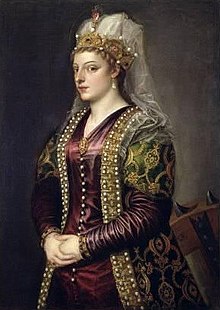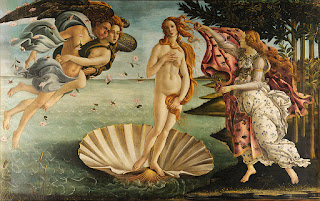Monarch lived out her last years in 'sweet idleness'
 |
| Titian's portrait of Caterina Cornaro, painted in around 1452 |
She had been living out her life in a castle in Asolo, a pretty town in the Veneto, after the Venetian Government persuaded her to abdicate as Queen of Cyprus.
Her court at the castle became a centre of literary and artistic excellence as she spent her days in what has been described as ‘sweet idleness,’ a translation of the verb asolare, invented by the poet Pietro Bembo to describe her daily life in the town.
Caterina was born in 1406 into the noble Cornaro family, which had produced four Doges, and she grew up in the family palace on the Grand Canal. The family had a long trading and business association with Cyprus.
Caterina was married by proxy to King James II of Cyprus in 1468, securing commercial rights and privileges for Venice in Cyprus. In 1472 she set sail for Cyprus and married James in person at Famagusta.
James died soon after the wedding and Caterina, who was by then pregnant, became regent of the kingdom, as was specified in his will. She was imprisoned briefly, after Cyprus was seized by the Archbishop of Nicosia, but restored to continue ruling after a military intervention by Venice.
After her son, James II, died just before his first birthday, she became the actual monarch of the kingdom.
| The castle at Asolo which was Caterina Cornaro's home from 1489 |
As a ruler she became an admired figure in contemporary European society and she was painted by great artists such as Durer, Titian, Gentile Bellini and Giorgione.
In 1489 she was persuaded to abdicate and to pass the control of Cyprus to the Republic of Venice.
Caterina was allowed to retain the title of Queen and was also made Lady of Asolo in return. The pageantry of the fleet carrying the exiled Queen home was captured in contemporary paintings and is now regarded as having been a brilliant piece of propaganda by the Venetian Republic.
Under Caterina, Asolo became a centre for late Renaissance art and learning. The painter Bellini and the poet Andrea Navagero spent time there. Bembo used Asolo as the setting for his dialogues on platonic love, Gli Asolani.
Caterina had more than 20 years of pleasurable life in Asolo before her death at the age of 55. Her grave is in the Church of San Salvador near the Rialto Bridge in Venice.
 |
| Piazza Giuseppe Garibaldi, the main square in the town of Asolo in the Veneto |
Asolo is a town in the Veneto region of northern Italy. It is known as ‘the pearl of the province of Treviso’ and also as ‘the city of a hundred horizons’ because of its beautiful views over the countryside and the mountains. The poet Robert Browning spent time in Asolo after he became a widower and he published Asolando, a volume of poetry written in the town, in 1889. The main road leading into the town is named Via Browning in his honour. One of the main sights is the Castle of Caterina Cornaro, which now houses the Eleonora Duse Theatre.
 |
| The facade of the Chiesa di San Salvador in Venice, where Caterina was buried |
Caterina died in Venice, having fled Asolo when her castle was occupied by imperial troops. She was buried in the Chiesa di San Salvatore, known in Venetian as San Salvador, which is in the Campo San Salvador along the Merceria, the main shopping street of Venice, and is close to the Rialto Bridge. As well as Caterina, the church houses the tombs of three Doges. It is rich in art works. The monument to one of the Doges, Francesco Venier, was sculpted by Jacopo Sansovino, and there are paintings by Titian and Francesco Vecellio among others.
More reading:
Pietro Bembo, the influential poet who was Lucrezia Borgia's lover
How the Bellini family became the most important artists in Venice
Titian: the Old Master who set new standards
Also on this day:
138AD: The death of Hadrian
1954: The death of Mafia chieftain Calogero Vizzini
Home

